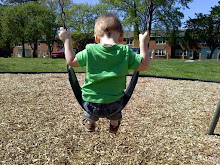I get asked this a lot, so I thought I would post something up here. :) AP is a parenting phrase coined by
Dr. Sears. It's not a set of rules, it's a set of tools. It's not an all or nothing thing. :) I will just outline the basic cocepts and how we use them in
our family.
7 ATTACHMENT TOOLS: THE BABY B'S
1. Birth bonding
I had a water birth. The lights were off. I was the one who caught him and I brought him directly onto my chest. We stayed there for a while before he was handed off to daddy. We stayed skin-to-skin for a long while! The earliest pictures of him were when we (me, Brandon and Corbin) were all in bed snuggling.
2. Breastfeeding
Breastfeeding promotes the right chemistry between mother and baby by stimulating your body to produce prolactin and oxytocin, hormones that give your mothering a boost. Oxytocin is known as the "love chemical". It is released with an unmedicated birth, breastfeeding and, oddly enough, during sex as well.
We breastfeed on demand and practice child-led weaning. We will continue to nurse until Corbin wants to stop (most toddlers wean themselves between 2 and 3).
3. Babywearing
Carried babies fuss less and spend more time in the state of quiet alertness, the behavior state in which babies learn most about their environment. Babywearing improves the sensitivity of the parents. Because your baby is so close to you, you get to know baby better. Closeness promotes familiarity.
I wear Corbin everywhere. :) We love it and I love it when he sleeps on me.
4. Bedding close to baby
We personally cosleep. we all snuggle together every night and I wake up to a smiling little one patting my face every morning. :) Co-sleeping adds a nighttime touch that helps busy daytime parents reconnect with their infant at night. Since nighttime is scary time for little people, sleeping within close touching and nursing distance minimizes nighttime separation anxiety and helps baby learn that sleep is a pleasant state to enter and a fearless state to remain in.
5. Belief in the language value of your baby's cry
A baby's cry is a signal designed for the survival of the baby and the development of the parents. Responding sensitively to your baby's cries builds trust. Babies trust that their caregivers will be responsive to their needs. Parents gradually learn to trust in their ability to appropriately meet their baby's needs. This raises the parent-child communication level up a notch. Tiny babies cry to communicate, not to manipulate. We have never, and will never, let him cry it out.
6. Beware of baby trainers
Attachment parenting teaches you how to be discerning of advice, especially those rigid and extreme parenting styles that teach you to watch a clock or a schedule instead of your baby; you know, the cry-it-out crowd. This "convenience" parenting is a short-term gain, but a long-term loss, and is not a wise investment. These more restrained styles of parenting create a distance between you and your baby and keep you from becoming an expert in your child.
7. Balance
In your zeal to give so much to your baby, it's easy to neglect the needs of yourself and your marriage. As you will learn the key to putting balance in your parenting is being appropriately responsive to your baby – knowing when to say "yes" and when to say "no," and having the wisdom to say "yes" to yourself when you need help.
What AP Parenting is NOTLove y'all!



